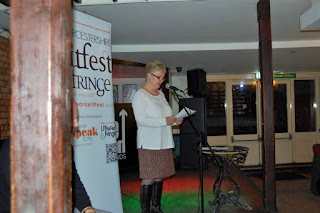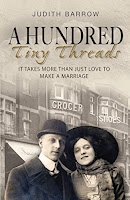November Done and Dusted
NaNoWriMo is over for another year. Well, the main event is anyway. Last Thursday, November 30th, I logged 33,086 words. It was not the 50,000 I'd hoped for but I was very pleased that my second novel, 'Whispering Olive Trees', now stands at over 74,000 words.
Should I be pleased that I'm 16,914 words short of my goal? The month started well but life then got in the way and I could have given up. However, apart from a day at the launch of the Flash Fiction anthology in Worcester I wrote about in the last blog post and a whole weekend when the family visited, I wrote every single day. Sometimes, it may have only been five or eight hundred words but they all added up. When I opened up my NaNo page the day after it had finished, I saw this:
I wasn't a NaNo winner but I was NaNo Writer. I'd got back into the novel, re-acquainted myself with my plot and got to know much more about my characters. Being with them in the warmth and sunshine of southern Greece certainly lifted my mood on some of those grey November days. The positive message from the NaNoWriMo team was this:
Wherever you're at in your novel, or energy-wise, you did something important this month: you took time to be a creator. You planned out new worlds and brought new characters into being. You followed your creative vision, and gave your story a voice.
What made this year special was a group of buddies who were there throughout supporting and encouraging me to keep going. Some, like me, didn't get to be 'winners' this time but all achieved so much over the thirty days; the interaction within the group was both motivating and inspiring. Thank you all. Special congratulations to those who did achieve their 50,000 goal! I'm so thrilled for them - Susanna Bavin, Kirsten Hesketh, Tara Greaves and my local Cowbridge buddy, Catherine Burrows.
THE BUSINESS OF BOOKS: IGNORING NOVEMBER – Jane Cable considers NaNoWriMo I was very pleased to contribute to Jane's article along with Susanna, Kirsten and another RNA member, Laura James. Click on the link to read what we had to say and how our experiences of NaNo differ.
 Before next November, there are other events during the year. Camp NaNoWriMo takes place every April and July. It's a 'lighter' version of the official NaNo. The rules are the same, except participants may choose any word count and may work on any writing project. It doesn't have to be a novel. A feature exclusive to Camp Nano is the cabins. These are virtual places for four to six participants. Writers have the option of inviting specific Wrimos into their cabin or joining a cabin where there are other writers of the same age, activity, word count goal or genre. They may also opt to join a random cabin or not join a cabin at all.There is a message board on which other Wrimos post messages for the other campers in their cabin.
Before next November, there are other events during the year. Camp NaNoWriMo takes place every April and July. It's a 'lighter' version of the official NaNo. The rules are the same, except participants may choose any word count and may work on any writing project. It doesn't have to be a novel. A feature exclusive to Camp Nano is the cabins. These are virtual places for four to six participants. Writers have the option of inviting specific Wrimos into their cabin or joining a cabin where there are other writers of the same age, activity, word count goal or genre. They may also opt to join a random cabin or not join a cabin at all.There is a message board on which other Wrimos post messages for the other campers in their cabin.
It has been said that NaNoWriMo is like marmite. Do you love it or loathe it? Did you take part in it this year? How did you get on?
Thank you for reading. You may also follow me on Twitter @JanBayLit and on my Jan Baynham Writer Facebook page.
NaNoWriMo is over for another year. Well, the main event is anyway. Last Thursday, November 30th, I logged 33,086 words. It was not the 50,000 I'd hoped for but I was very pleased that my second novel, 'Whispering Olive Trees', now stands at over 74,000 words.
Should I be pleased that I'm 16,914 words short of my goal? The month started well but life then got in the way and I could have given up. However, apart from a day at the launch of the Flash Fiction anthology in Worcester I wrote about in the last blog post and a whole weekend when the family visited, I wrote every single day. Sometimes, it may have only been five or eight hundred words but they all added up. When I opened up my NaNo page the day after it had finished, I saw this:
I wasn't a NaNo winner but I was NaNo Writer. I'd got back into the novel, re-acquainted myself with my plot and got to know much more about my characters. Being with them in the warmth and sunshine of southern Greece certainly lifted my mood on some of those grey November days. The positive message from the NaNoWriMo team was this:
Wherever you're at in your novel, or energy-wise, you did something important this month: you took time to be a creator. You planned out new worlds and brought new characters into being. You followed your creative vision, and gave your story a voice.
What made this year special was a group of buddies who were there throughout supporting and encouraging me to keep going. Some, like me, didn't get to be 'winners' this time but all achieved so much over the thirty days; the interaction within the group was both motivating and inspiring. Thank you all. Special congratulations to those who did achieve their 50,000 goal! I'm so thrilled for them - Susanna Bavin, Kirsten Hesketh, Tara Greaves and my local Cowbridge buddy, Catherine Burrows.
THE BUSINESS OF BOOKS: IGNORING NOVEMBER – Jane Cable considers NaNoWriMo I was very pleased to contribute to Jane's article along with Susanna, Kirsten and another RNA member, Laura James. Click on the link to read what we had to say and how our experiences of NaNo differ.
 Before next November, there are other events during the year. Camp NaNoWriMo takes place every April and July. It's a 'lighter' version of the official NaNo. The rules are the same, except participants may choose any word count and may work on any writing project. It doesn't have to be a novel. A feature exclusive to Camp Nano is the cabins. These are virtual places for four to six participants. Writers have the option of inviting specific Wrimos into their cabin or joining a cabin where there are other writers of the same age, activity, word count goal or genre. They may also opt to join a random cabin or not join a cabin at all.There is a message board on which other Wrimos post messages for the other campers in their cabin.
Before next November, there are other events during the year. Camp NaNoWriMo takes place every April and July. It's a 'lighter' version of the official NaNo. The rules are the same, except participants may choose any word count and may work on any writing project. It doesn't have to be a novel. A feature exclusive to Camp Nano is the cabins. These are virtual places for four to six participants. Writers have the option of inviting specific Wrimos into their cabin or joining a cabin where there are other writers of the same age, activity, word count goal or genre. They may also opt to join a random cabin or not join a cabin at all.There is a message board on which other Wrimos post messages for the other campers in their cabin. It has been said that NaNoWriMo is like marmite. Do you love it or loathe it? Did you take part in it this year? How did you get on?
Thank you for reading. You may also follow me on Twitter @JanBayLit and on my Jan Baynham Writer Facebook page.























